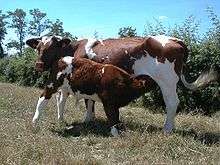Maine-Anjou cattle
 Cow and calf | |
| Conservation status | FAO (2007): no concern[1]:144 |
|---|---|
| Other names |
|
| Country of origin | France |
| Distribution | |
| Use | formerly dual-purpose, now mainly for beef |
| Traits | |
| Weight | |
| Height | |
| Coat | red pied |
| Horn status | horned in both sexes[3] |
| |
The Maine-Anjou is a French breed of domestic cattle, raised mainly in the Pays de la Loire region in north-western France. It was created in the nineteenth century in the historic province of Maine by cross-breeding the local Mancelle dairy cattle with Durham stock from Britain, and was at first called the Durham-Mancelle. In France it has been known since 2004 as the Rouge des Prés, but the Maine-Anjou name continues to be used elsewhere. It was formerly a dual-purpose animal, raised both for meat and for milk, but is now principally a beef breed.
History
The Maine-Anjou breed was created in the nineteenth century by owners of large estates in the traditional province of Maine, who cross-bred the local Mancelle dairy cattle with British Durham cattle – the breed that would later become the Shorthorn.[2]:236 The resulting dual-purpose breed was thus originally known as the Durham-Mancelle. A herd-book was started in 1908, and the name of the breed was changed to Maine-Anjou. It was changed again in 2004, to Rouge des Prés, but outside France the older name continues to be used.[2]:236 From about 1970, breeding favoured beef production over dairy use. The Maine-Anjou may display the genetic myostatin deficiency which produces "double muscling", but has not been selectively bred for this attribute.[2]:236
The Maine-Anjou is reported from eight countries in the world, with an estimated total population of about 60000, of which approximately two thirds are in France.[4] Of these, some 90% are in the Pays de la Loire, and most of the remainder in the neighbouring Basse-Normandie and Poitou-Charentes regions.[2]:236 About one third of the world population is in the United States, where registrations began in 1969.[2]:236
Use
The Maine-Anjou was created as a dual-purpose breed, for both beef and milk. Since about 1970 it has been raised predominantly for beef. Maine Anjou beef from Rouge des Prés cattle raised in the départements of the Deux-Sèvres, the Ille-et-Vilaine, the Loire-Atlantique, the Maine-et-Loire, the Mayenne, the Orne, the Sarthe and the Vendée received Appellation d'Origine Protégée status in 2010.[5]
References
- ↑ Barbara Rischkowsky, D. Pilling (eds.) (2007). List of breeds documented in the Global Databank for Animal Genetic Resources, annex to The State of the World's Animal Genetic Resources for Food and Agriculture. Rome: Food and Agriculture Organization of the United Nations. ISBN 9789251057629. Accessed November 2016.
- 1 2 3 4 5 6 7 8 9 Valerie Porter, Lawrence Alderson, Stephen J.G. Hall, D. Phillip Sponenberg (2016). Mason's World Encyclopedia of Livestock Breeds and Breeding (sixth edition). Wallingford: CABI. ISBN 9781780647944.
- ↑ Rouge des prés/France. Domestic Animal Diversity Information System of the Food and Agriculture Organization of the United Nations. Accessed November 2016.
- ↑ Transboundary breed: Maine-Anjou. Domestic Animal Diversity Information System of the Food and Agriculture Organization of the United Nations. Accessed November 2016.
- ↑ [s.n.] (21 December 2010). La viande Maine Anjou obtient l'Appellation d'Origine Protégée (AOP) (in French). La Dépêche du Midi.
![]() Media related to Maine-Anjou cattle at Wikimedia Commons
Media related to Maine-Anjou cattle at Wikimedia Commons